Case Study: FreshDirect's Strategy and Webvan's E-commerce Failure
VerifiedAdded on 2022/08/13
|5
|1047
|24
Case Study
AI Summary
This case study examines the contrasting business models of FreshDirect and Webvan, two online grocery retailers. It analyzes the reasons behind Webvan's failure, including lack of experience, infrastructure issues, and failure to understand customer behavior, while highlighting FreshDirect's success through logistics, cost-cutting, and item accuracy. The study applies Porter's five forces to FreshDirect, assessing the competitive landscape and identifying strategies for attracting and retaining customers using Web 2.0 technologies. The analysis emphasizes the importance of quality, logistics, and continuous cost reduction for success in the online grocery market, alongside the need for adapting to changing customer expectations through technology and social media integration.
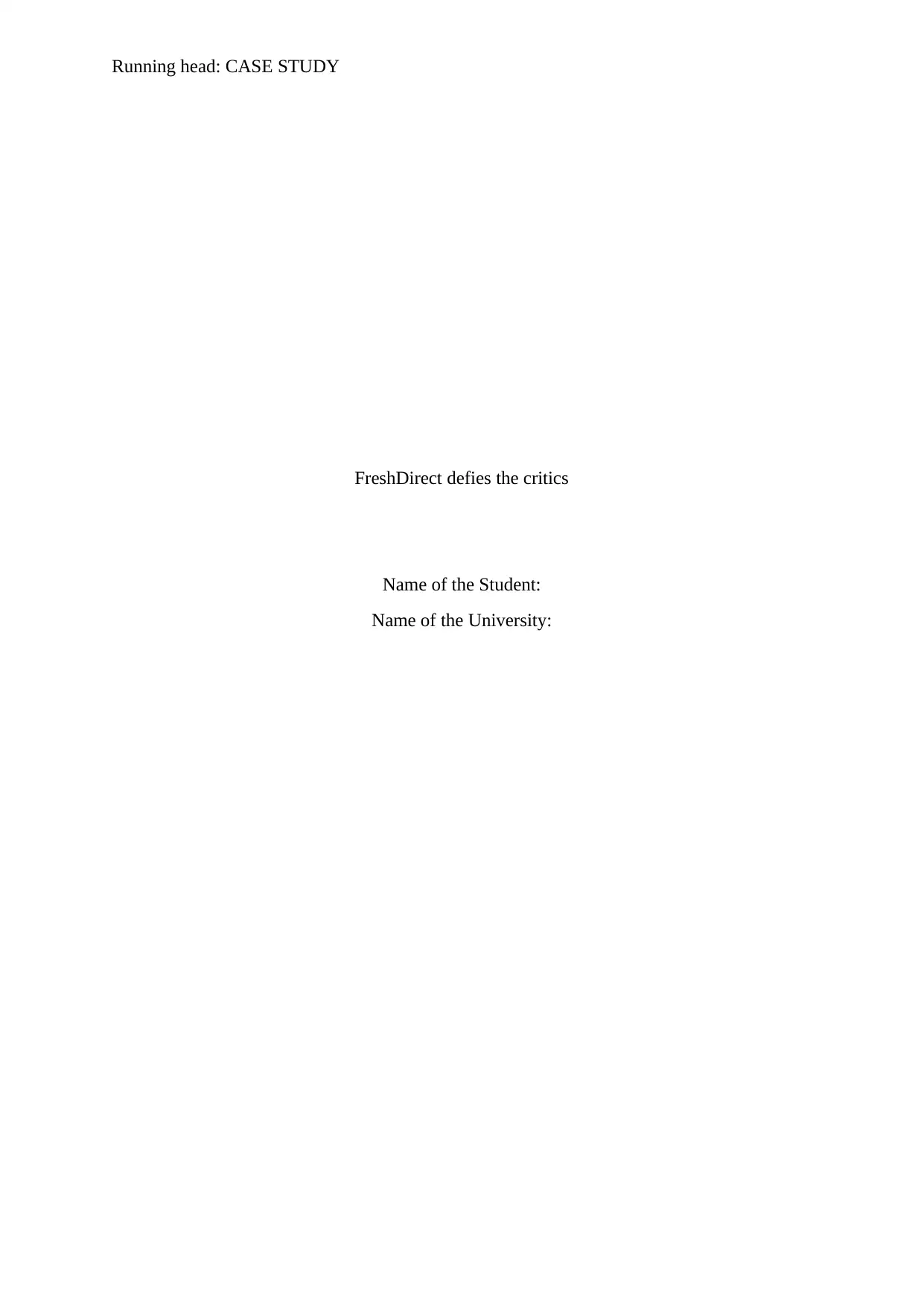
Running head: CASE STUDY
FreshDirect defies the critics
Name of the Student:
Name of the University:
FreshDirect defies the critics
Name of the Student:
Name of the University:
Paraphrase This Document
Need a fresh take? Get an instant paraphrase of this document with our AI Paraphraser
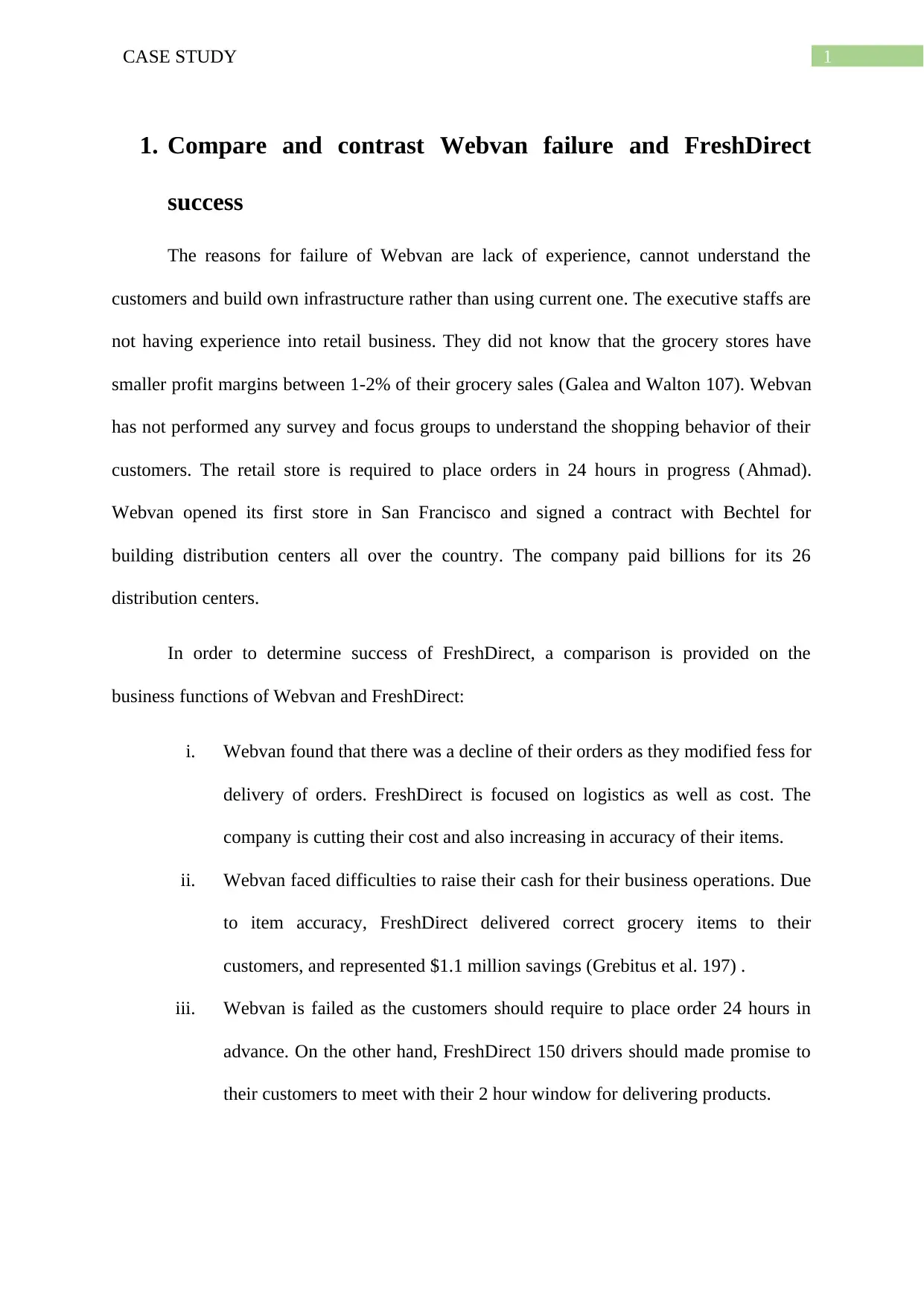
1CASE STUDY
1. Compare and contrast Webvan failure and FreshDirect
success
The reasons for failure of Webvan are lack of experience, cannot understand the
customers and build own infrastructure rather than using current one. The executive staffs are
not having experience into retail business. They did not know that the grocery stores have
smaller profit margins between 1-2% of their grocery sales (Galea and Walton 107). Webvan
has not performed any survey and focus groups to understand the shopping behavior of their
customers. The retail store is required to place orders in 24 hours in progress (Ahmad).
Webvan opened its first store in San Francisco and signed a contract with Bechtel for
building distribution centers all over the country. The company paid billions for its 26
distribution centers.
In order to determine success of FreshDirect, a comparison is provided on the
business functions of Webvan and FreshDirect:
i. Webvan found that there was a decline of their orders as they modified fess for
delivery of orders. FreshDirect is focused on logistics as well as cost. The
company is cutting their cost and also increasing in accuracy of their items.
ii. Webvan faced difficulties to raise their cash for their business operations. Due
to item accuracy, FreshDirect delivered correct grocery items to their
customers, and represented $1.1 million savings (Grebitus et al. 197) .
iii. Webvan is failed as the customers should require to place order 24 hours in
advance. On the other hand, FreshDirect 150 drivers should made promise to
their customers to meet with their 2 hour window for delivering products.
1. Compare and contrast Webvan failure and FreshDirect
success
The reasons for failure of Webvan are lack of experience, cannot understand the
customers and build own infrastructure rather than using current one. The executive staffs are
not having experience into retail business. They did not know that the grocery stores have
smaller profit margins between 1-2% of their grocery sales (Galea and Walton 107). Webvan
has not performed any survey and focus groups to understand the shopping behavior of their
customers. The retail store is required to place orders in 24 hours in progress (Ahmad).
Webvan opened its first store in San Francisco and signed a contract with Bechtel for
building distribution centers all over the country. The company paid billions for its 26
distribution centers.
In order to determine success of FreshDirect, a comparison is provided on the
business functions of Webvan and FreshDirect:
i. Webvan found that there was a decline of their orders as they modified fess for
delivery of orders. FreshDirect is focused on logistics as well as cost. The
company is cutting their cost and also increasing in accuracy of their items.
ii. Webvan faced difficulties to raise their cash for their business operations. Due
to item accuracy, FreshDirect delivered correct grocery items to their
customers, and represented $1.1 million savings (Grebitus et al. 197) .
iii. Webvan is failed as the customers should require to place order 24 hours in
advance. On the other hand, FreshDirect 150 drivers should made promise to
their customers to meet with their 2 hour window for delivering products.
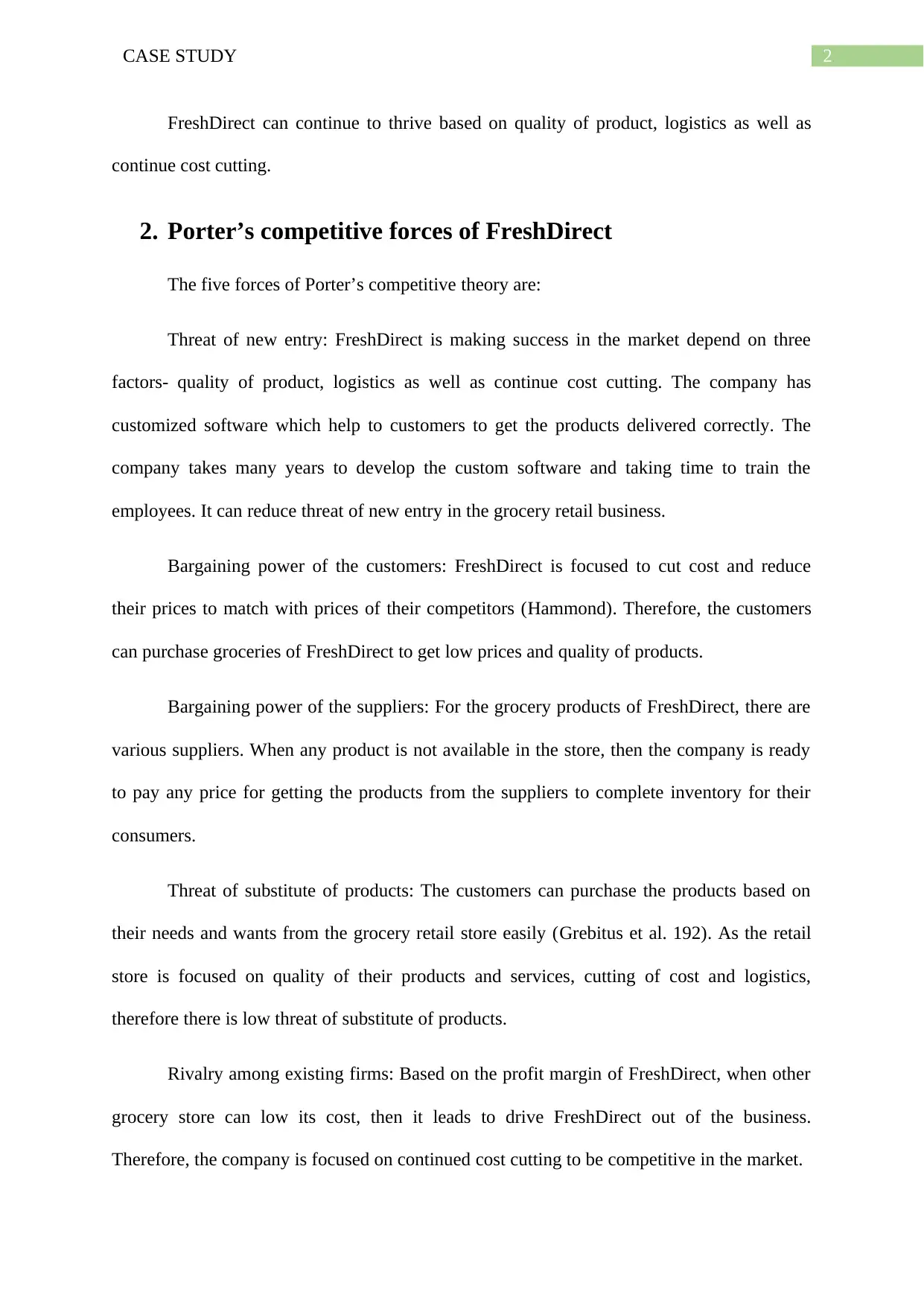
2CASE STUDY
FreshDirect can continue to thrive based on quality of product, logistics as well as
continue cost cutting.
2. Porter’s competitive forces of FreshDirect
The five forces of Porter’s competitive theory are:
Threat of new entry: FreshDirect is making success in the market depend on three
factors- quality of product, logistics as well as continue cost cutting. The company has
customized software which help to customers to get the products delivered correctly. The
company takes many years to develop the custom software and taking time to train the
employees. It can reduce threat of new entry in the grocery retail business.
Bargaining power of the customers: FreshDirect is focused to cut cost and reduce
their prices to match with prices of their competitors (Hammond). Therefore, the customers
can purchase groceries of FreshDirect to get low prices and quality of products.
Bargaining power of the suppliers: For the grocery products of FreshDirect, there are
various suppliers. When any product is not available in the store, then the company is ready
to pay any price for getting the products from the suppliers to complete inventory for their
consumers.
Threat of substitute of products: The customers can purchase the products based on
their needs and wants from the grocery retail store easily (Grebitus et al. 192). As the retail
store is focused on quality of their products and services, cutting of cost and logistics,
therefore there is low threat of substitute of products.
Rivalry among existing firms: Based on the profit margin of FreshDirect, when other
grocery store can low its cost, then it leads to drive FreshDirect out of the business.
Therefore, the company is focused on continued cost cutting to be competitive in the market.
FreshDirect can continue to thrive based on quality of product, logistics as well as
continue cost cutting.
2. Porter’s competitive forces of FreshDirect
The five forces of Porter’s competitive theory are:
Threat of new entry: FreshDirect is making success in the market depend on three
factors- quality of product, logistics as well as continue cost cutting. The company has
customized software which help to customers to get the products delivered correctly. The
company takes many years to develop the custom software and taking time to train the
employees. It can reduce threat of new entry in the grocery retail business.
Bargaining power of the customers: FreshDirect is focused to cut cost and reduce
their prices to match with prices of their competitors (Hammond). Therefore, the customers
can purchase groceries of FreshDirect to get low prices and quality of products.
Bargaining power of the suppliers: For the grocery products of FreshDirect, there are
various suppliers. When any product is not available in the store, then the company is ready
to pay any price for getting the products from the suppliers to complete inventory for their
consumers.
Threat of substitute of products: The customers can purchase the products based on
their needs and wants from the grocery retail store easily (Grebitus et al. 192). As the retail
store is focused on quality of their products and services, cutting of cost and logistics,
therefore there is low threat of substitute of products.
Rivalry among existing firms: Based on the profit margin of FreshDirect, when other
grocery store can low its cost, then it leads to drive FreshDirect out of the business.
Therefore, the company is focused on continued cost cutting to be competitive in the market.
⊘ This is a preview!⊘
Do you want full access?
Subscribe today to unlock all pages.

Trusted by 1+ million students worldwide
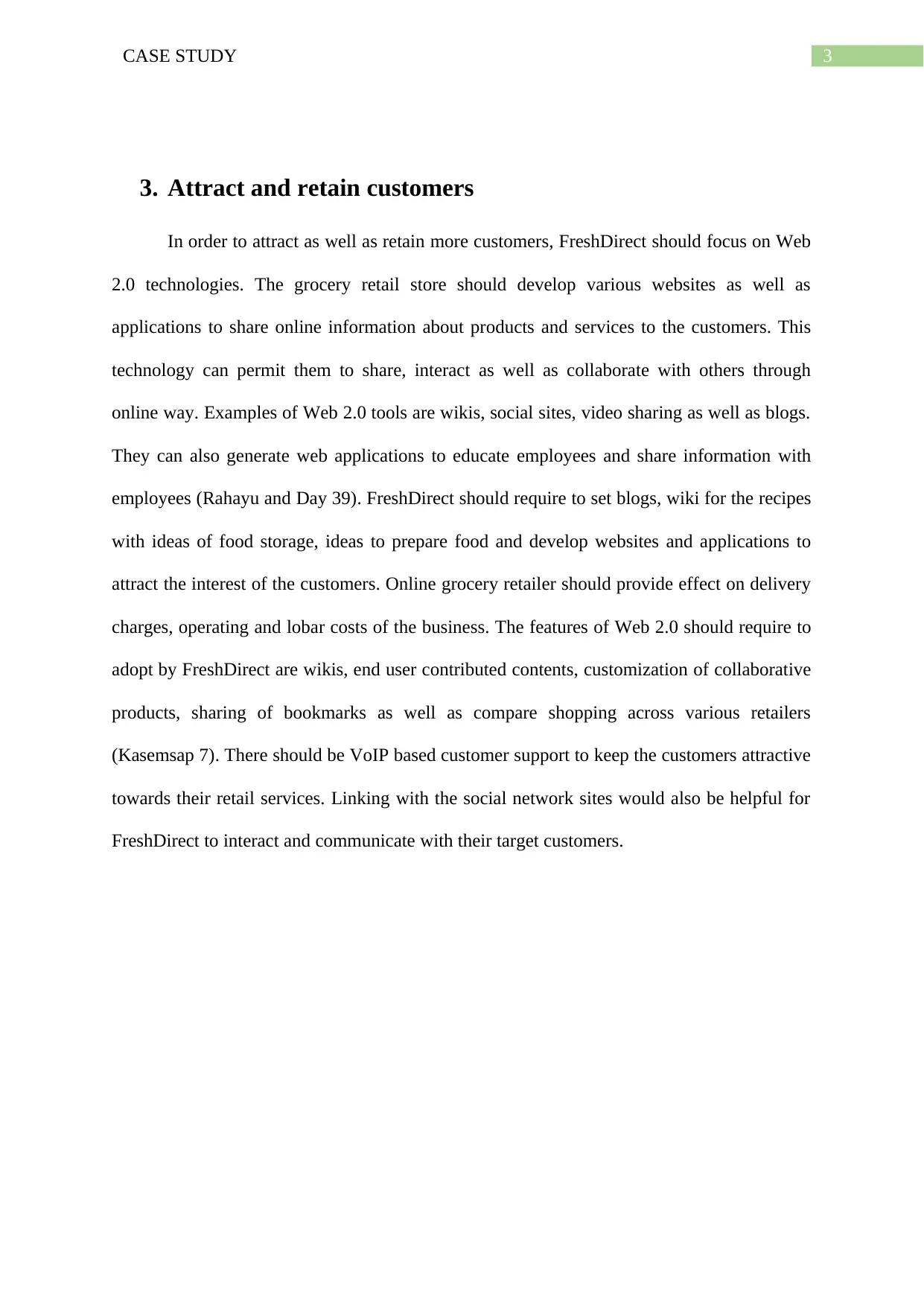
3CASE STUDY
3. Attract and retain customers
In order to attract as well as retain more customers, FreshDirect should focus on Web
2.0 technologies. The grocery retail store should develop various websites as well as
applications to share online information about products and services to the customers. This
technology can permit them to share, interact as well as collaborate with others through
online way. Examples of Web 2.0 tools are wikis, social sites, video sharing as well as blogs.
They can also generate web applications to educate employees and share information with
employees (Rahayu and Day 39). FreshDirect should require to set blogs, wiki for the recipes
with ideas of food storage, ideas to prepare food and develop websites and applications to
attract the interest of the customers. Online grocery retailer should provide effect on delivery
charges, operating and lobar costs of the business. The features of Web 2.0 should require to
adopt by FreshDirect are wikis, end user contributed contents, customization of collaborative
products, sharing of bookmarks as well as compare shopping across various retailers
(Kasemsap 7). There should be VoIP based customer support to keep the customers attractive
towards their retail services. Linking with the social network sites would also be helpful for
FreshDirect to interact and communicate with their target customers.
3. Attract and retain customers
In order to attract as well as retain more customers, FreshDirect should focus on Web
2.0 technologies. The grocery retail store should develop various websites as well as
applications to share online information about products and services to the customers. This
technology can permit them to share, interact as well as collaborate with others through
online way. Examples of Web 2.0 tools are wikis, social sites, video sharing as well as blogs.
They can also generate web applications to educate employees and share information with
employees (Rahayu and Day 39). FreshDirect should require to set blogs, wiki for the recipes
with ideas of food storage, ideas to prepare food and develop websites and applications to
attract the interest of the customers. Online grocery retailer should provide effect on delivery
charges, operating and lobar costs of the business. The features of Web 2.0 should require to
adopt by FreshDirect are wikis, end user contributed contents, customization of collaborative
products, sharing of bookmarks as well as compare shopping across various retailers
(Kasemsap 7). There should be VoIP based customer support to keep the customers attractive
towards their retail services. Linking with the social network sites would also be helpful for
FreshDirect to interact and communicate with their target customers.
Paraphrase This Document
Need a fresh take? Get an instant paraphrase of this document with our AI Paraphraser
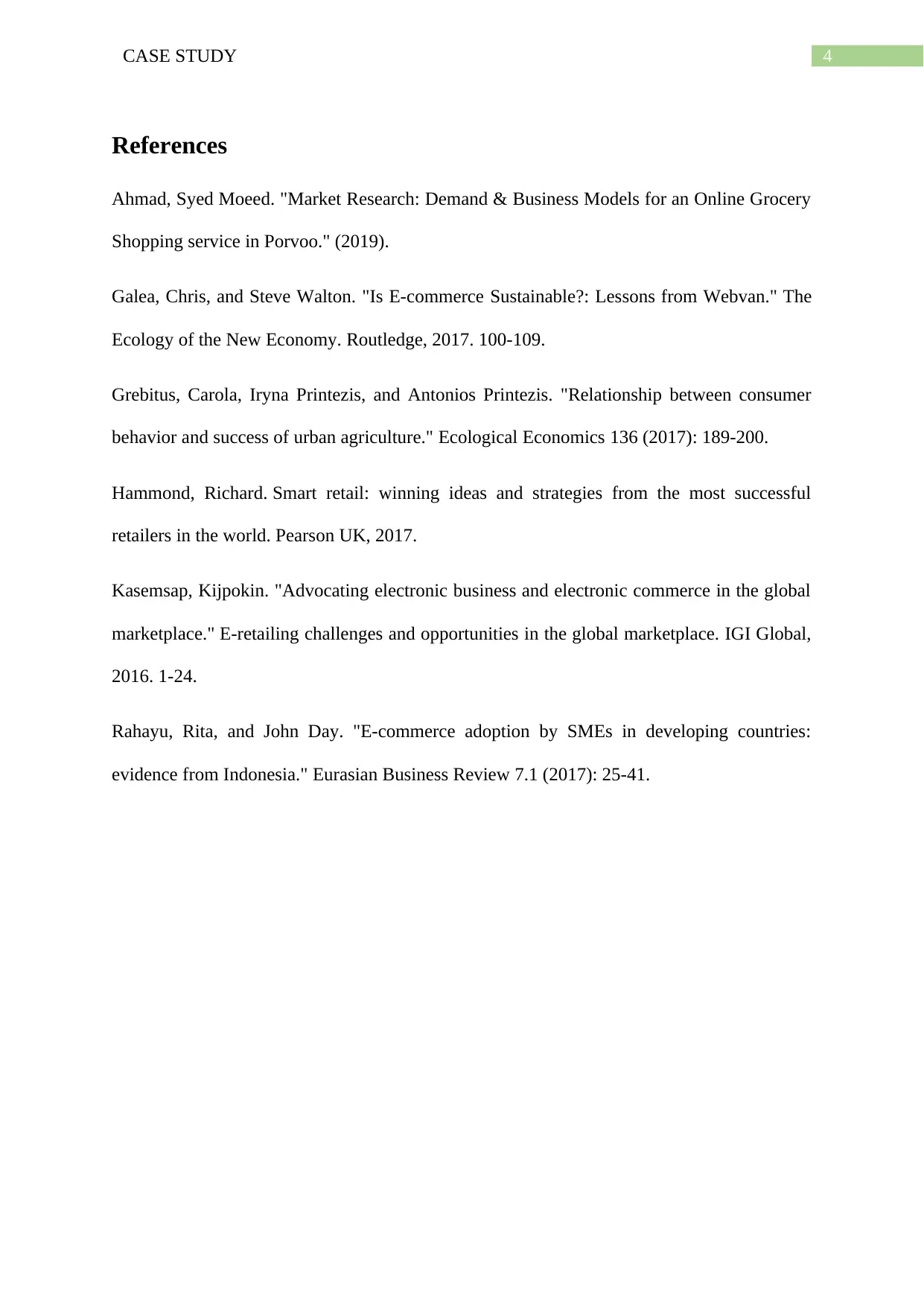
4CASE STUDY
References
Ahmad, Syed Moeed. "Market Research: Demand & Business Models for an Online Grocery
Shopping service in Porvoo." (2019).
Galea, Chris, and Steve Walton. "Is E-commerce Sustainable?: Lessons from Webvan." The
Ecology of the New Economy. Routledge, 2017. 100-109.
Grebitus, Carola, Iryna Printezis, and Antonios Printezis. "Relationship between consumer
behavior and success of urban agriculture." Ecological Economics 136 (2017): 189-200.
Hammond, Richard. Smart retail: winning ideas and strategies from the most successful
retailers in the world. Pearson UK, 2017.
Kasemsap, Kijpokin. "Advocating electronic business and electronic commerce in the global
marketplace." E-retailing challenges and opportunities in the global marketplace. IGI Global,
2016. 1-24.
Rahayu, Rita, and John Day. "E-commerce adoption by SMEs in developing countries:
evidence from Indonesia." Eurasian Business Review 7.1 (2017): 25-41.
References
Ahmad, Syed Moeed. "Market Research: Demand & Business Models for an Online Grocery
Shopping service in Porvoo." (2019).
Galea, Chris, and Steve Walton. "Is E-commerce Sustainable?: Lessons from Webvan." The
Ecology of the New Economy. Routledge, 2017. 100-109.
Grebitus, Carola, Iryna Printezis, and Antonios Printezis. "Relationship between consumer
behavior and success of urban agriculture." Ecological Economics 136 (2017): 189-200.
Hammond, Richard. Smart retail: winning ideas and strategies from the most successful
retailers in the world. Pearson UK, 2017.
Kasemsap, Kijpokin. "Advocating electronic business and electronic commerce in the global
marketplace." E-retailing challenges and opportunities in the global marketplace. IGI Global,
2016. 1-24.
Rahayu, Rita, and John Day. "E-commerce adoption by SMEs in developing countries:
evidence from Indonesia." Eurasian Business Review 7.1 (2017): 25-41.
1 out of 5
Related Documents
Your All-in-One AI-Powered Toolkit for Academic Success.
+13062052269
info@desklib.com
Available 24*7 on WhatsApp / Email
![[object Object]](/_next/static/media/star-bottom.7253800d.svg)
Unlock your academic potential
Copyright © 2020–2025 A2Z Services. All Rights Reserved. Developed and managed by ZUCOL.




